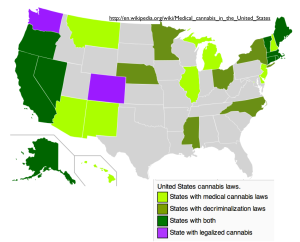The problem with marijuana accident statistics
“Statistics are like bikinis. What they reveal is suggestive, but what they conceal is vital.” ~Aaron Levenstein
Unless you’ve been in a coma tha last five years you have certainly heard many pros and cons arguments regarding the legalization of marijuana for medical and recreational use. When you consider the overall implications to society, individual’s physical and mental health, public safety, effect on minority populations, costs of enforcement, taxation, illegal markets, and so on the issue can be quite complex and difficult to come to any definite conclusions. As with most large-scale public policy issue there are valid arguments to be made supporting each side. Some arguments may never get sorted out, while others can be resolved over time as evidence builds and statistics can be compiled. A good example of this would be vaccinations. Over time we can compile reliable information regarding the safety and effectiveness of vaccinations and for the most part American society has come to accept that the pros of vaccination outweigh the cons. Even California finally caved in and passed mandatory vaccinations for public and private school students. That’s what solid, reliable, statistical data can accomplish.
In the great marijuana debate, there are a lot of claims floating about regarding whether or not marijuana use has an effect of workplace accidents. Talk to a pro-marijuana advocate and they’ll likely cite some website claiming that no or little statistical evidence exists that definitively links marijuana use to a higher rate of workplace accidents (or driving accidents). Are they right?
Many U.S. businesses are re-evaluating their workplace drug testing policies due to the rapidly changing state laws and public perception. It would be helpful for them to have conclusive evidence that marijuana either does or does not have an effect of safety. Workplace safety typically trumps all other issues. Companies can justify nearly any precaution that improves workplace safety and reduces potential liabilities.
The problem with Marijuana and workplace safety statistics
In 1987, an Amtrack/Conrail train collision near Baltimore killed 14 passengers, an engineer and car attendant. The Conrail crew failed to slow at a critical point resulting in the collision. They also tested positive for marijuana in post accident testing. The crash was instrumental in the FRA overhauling their drug and alcohol testing policy and later in 1991, Congress authorize random testing for many DOT regulated transportation industries. In 1993, in an interview with the Baltimore Sun, Ricky Lynn Gates, the Conrail engineer confessed to smoking marijuana stating that the accident would never have happened had he not been smoking marijuana. However, with all that information what was the “official cause” of the accident attributed to? It was officially listed as ”the outrageous conduct of the Conrail crew”
Where can we find reliable data?
Here’s a start…
30% of participants who consumed THC showed visible impairments in a field sobriety study – Psychopharmacology Oct 2012 223:(4) 439-446.
50% of participants showed a positive relationship between THC use and failed field sobriety tests. – 2005 Jun;180(1):107-14. Epub 2004 Dec 24.
“laboratory tests and driving studies show that cannabis may acutely impair several driving-related skills in a dose-related fashion” -Am J Addict. Author manuscript; available in PMC 2010 May 1. Published in final edited form as: Am J Addict. 2009; 18(3): 185–193. doi: 10.1080/10550490902786934
“Drivers with blood concentrations of 13.1 ug/L THC, the psychoactive ingredient in cannabis, showed increase weaving that was similar to those with a .08 breath alcohol concentration, the legal limit in most states.” – http://time.com/3930541/marijuana-impact-driving/
“laboratory research has suggested similarly that marijuana impairs tasks of selective and divided attention, time estimation, and executive function” & ““the acute effect of moderate or higher doses of marijuana impairs the skills related to safe driving and injury risk”, particularly “attention, tracking and psychomotor skills” – http://adai.washington.edu/marijuana/factsheets/driving.htm
“A more recent study revealed that increasing instances of driving under the influence of marijuana are associated with an increased risk of motor vehicle accidents. More specifically, after adjusting for confounding variables, young adults in a New Zealand birth cohort who drove under the influence of marijuana more than 20 times across a 4 year period had a risk of collisions 1.4 times greater than did those who had never driven under the influence of marijuana.30 Finally, driver culpability studies have suggested that drivers testing positive to marijuana are significantly more likely to be responsible for fatal car crashes than are drug-free drivers.” – http://adai.washington.edu/marijuana/factsheets/driving.htm#sthash.hioc0SLu.dpuf
One more consideration
Today’s marijuana is three times stronger than that of the 70’s. So most studies performed to date are likely outdated, and testing strains that have lower psychological effects of users.
AtHandTraining.com provides awesome online training for DOT Supervisor for reasonable suspicion training and for DOT employees for drug and alcohol awareness training.
Buy now and begin training in minutes!


